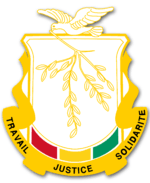Elections in Guinea
 |
|---|
| This article is part of a series on the politics and government of Guinea |
|
Constitution |
|
Parliament
|
Guinea elects on the national level a head of state—the president—and a legislature. The president is elected for a five-year term by the people through a two-round system (i.e. if no candidate secures a majority of the votes, there is a runoff between the top two vote-getters).[1] The National Assembly (Assemblée Nationale) has 114 members, elected for five-year terms, 38 members in single-seat constituencies and 76 members by proportional representation.[1][2]
Voters must be at least 18 years old and Guinean citizens in full possession of civil and political rights.[2] Candidates must be at 18, either Guinean by citizenship or naturalized and resident in the country for at least 10 years.[2] There are also various disqualifications.[2]
History
When Guinea gained its independence from France in 1958, Ahmed Sékou Touré became its first president, as his Parti démocratique de Guinée (DPG, Democratic Party of Guinea) had won 56 of 60 seats in the 1957 Territorial Assembly election.[3] By 1960, he had declared the DPG the only legal party, so, for the next 24 years, all the voters could do was elect the DPG candidates to the National Assembly, while Touré ran unopposed for the presidency three more times.[4]
After Touré's death in 1984, Colonels Lansana Conté and Diarra Traoré seized power in a bloodless coup d'état, with Conté assuming the presidency.[4] In December 1990, a new constitution created a unicameral Parliament.[5] In April 1992, legislation was passed making Guinea a multi-party state.[5] The following year, Conté announced a return to civilian rule, with Guinea's first multi-party presidential election taking place in 1993,[6] followed by a legislative election in 1995.[5] Conté remained president, with 51.7% of the vote, while his Party of Unity and Progress (PUP, Parti de l'Unité et du Progrès) won 71 of the 114 seats in the Assembly.[5][7] He was re-elected president in 1998, with 56.1% of the vote, and 2003, with 95.6% of the vote after all the major opposition leaders boycotted the election.[4][7] His party also won 85 seats in the Assembly in 2002, with some opposition parties choosing to boycott.[8]
Shortly after Conté's death in December 2008, Moussa Dadis Camara seized power.[4][7] In December 2009, Camara was shot in the head in an assassination attempt and left the country to obtain medical care.[4][7] The following month, Camara agreed to a return to civilian rule.
No candidate won a majority of the votes in the first round of the 2010 presidential election, so Cellou Dalein Diallo and Alpha Condé, the top vote-getters (with 43.69% and 18.25%, respectively), contested a second round, which was delayed several times.[7] Condé finally emerged victorious,[7] with 52.54% of the ballots. His Guinean People's Assembly party (RPG, Rassemblement du Peuple Guinéen) took 53 of the 114 Assembly seats in the repeatedly delayed 2013 election, and seven seats won by allies gave the RPG a majority.[9][10] He himself was re-elected in 2015.[11]
Latest elections
2015 presidential election
Alpha Condé is re-elected.
| Candidate | Party | Votes | % |
|---|---|---|---|
| Alpha Condé | Rally of the Guinean People | 2,285,827 | 57.85 |
| Cellou Dalein Diallo | Union of Democratic Forces of Guinea | 1,242,362 | 31.44 |
| Sidya Touré | Union of Republican Forces | 237,549 | 6.01 |
| Faya Lansana Millimouno | Liberal Bloc | 54,718 | 1.38 |
| El Hadj Papa Koly Kourouma | Generations for Reconciliation, Union, and Prosperity | 51,750 | 1.31 |
| Lansana Kouyaté | National Party for Hope and Development | 45,962 | 1.16 |
| Ghandi Faraguet Tounkara | Guinean Union for Democracy and Development | 19,840 | 0.50 |
| Marie Madeilein Dioubaté | Guinea Ecologists Party | 13,214 | 0.33 |
| Invalid/blank votes | 179,804 | – | |
| Total | 4,131,026 | 100 | |
| Registered voters/turnout | 6,042,634 | 68.36 | |
| Source: CENI (98.2% of polling stations reporting) | |||
2013 legislative election
Past elections
Election commission
The Independent National Electoral Commission (French: Commission Electorale Nationale Indépendante, CENI) is the election commission in Guinea.[12] The body was established in November 2007.[13]
See also
References
- 1 2 "Oct. 11, 2015: Republic of Guinea". International Foundation for Electoral Systems.
- 1 2 3 4 "Guinea Assemblée nationale (National Assembly): Electoral System". Inter-Parliamentary Union.
- ↑ "Elections in Guinea: 31 March 1957 Territorial Assembly Election". africanelections.tripod.com. African Elections Database.
- 1 2 3 4 5 Tyson Roberts (20 October 2015). "5 things you should know about Guinea's (peaceful!) election". The Washington Post.
- 1 2 3 4 "Guinea Parliamentary Chamber: Assemblée nationale: Elections Held in 1995". Inter-Parliamentary Union.
- ↑ "Lansana Conté". The Telegraph. 30 December 2008.
- 1 2 3 4 5 6 "Guinea profile - Timeline". BBC. 1 September 2016.
- ↑ "Guinea Assemblée nationale (National Assembly): Elections in 2002". Inter-Parliamentary Union.
- ↑ "Guinea Assemblée nationale (National Assembly): Last Elections". Inter-Parliamentary Union.
- ↑ "Guinea: Strengthening Guinea's Democratic Institutions". National Democratic Institute.
- ↑ Dionne Searcey (1 November 2015). "Guinea President's Re-election Confirmed Despite Fraud Complaints". The New York Times.
- ↑ "La Mission d'observation électorale de l'Union européenne encourage la CENI à publier tous les résultats détaillés par bureau de vote dans les plus brefs délais au niveau central" (PDF) (in French). European External Action Service. 19 October 2015. Retrieved 20 October 2015.
- ↑ "Elections in doubt for 2008". IRIN. 28 June 2008.